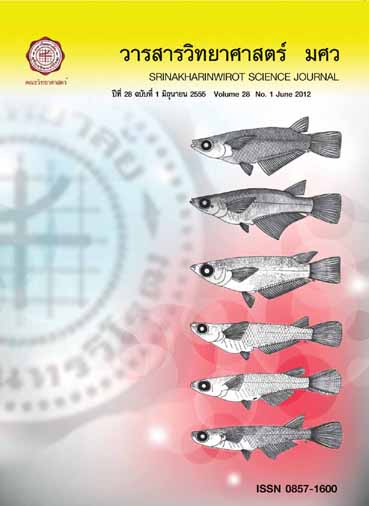การศึกษาคุณภาพและความปลอดภัยของขนมจีน (A Study of Quality and Safety of Kanom Jien (Fermented and Fresh Rice Noodle))
Keywords:
ขนมจีน คุณภาพทางจุลินทรีย์ วัตถุกันเสีย fermented rice noodle (Kanom Jien), microbiological quality, preservativesAbstract
จากการสุ่มตัวอย่างขนมจีนจากโรงงานที่ผลิตขนมจีน 77 แห่งจาก 257 แห่งทั่วประเทศ พบว่า มีโรงงานผลิตขนมจีนที่เข้าข่ายโรงงานตามพระราชบัญญัติโรงงาน (พ.ศ. 2535) ร้อยละ 58.44 และไม่เข้าข่ายโรงงานร้อยละ 41.56 เมื่อทำการสุ่มสำรวจคุณภาพขนมจีนจากสถานที่ผลิตขนมจีนทั้ง 77 แห่ง โดยทำการตรวจวิเคราะห์คุณภาพทั้งทางด้านจุลชีววิทยา ได้แก่ จำนวนจุลินทรีย์ทั้งหมด coliforms, Escherichia coli, Staphylococcus aureus และ Bacillus cereus ทางด้านเคมี ได้แก่ วัตถุกันเสีย คือ กรดเบนโซอิก และกรดซอร์บิก และค่าความเป็นกรดด่างของขนมจีน จากผลการวิเคราะห์ พบจุลินทรีย์เกินเกณฑ์มาตรฐานที่กำหนดโดยกรมวิทยาศาสตร์การแพทย์ 10 ตัวอย่างดังนี้ ตัวอย่างที่พบจุลินทรีย์ทั้งหมดเกินมาตรฐานร้อยละ 3.90 coliforms ร้อยละ 1.30 E. coli ร้อยละ 1.30 S. aureus ร้อยละ 1.30 พบตัวอย่างที่จำนวนจุลินทรีย์ทั้งหมดและ coliforms เกินมาตรฐานร้อยละ 3.90 และตัวอย่างที่พบจำนวนจุลินทรีย์ทั้งหมด coliforms และ E. coli ร้อยละ 1.30 ตัวอย่างที่นำมาศึกษาทั้งหมดตรวจไม่พบ B. cereus ส่วนผลการตรวจวิเคราะห์ด้านเคมีพบการใช้กรดเบนโซอิกเกินมาตรฐานตามที่ Codex กำหนด เพียง 1 ตัวอย่าง (ร้อยละ 1.30) พบการใช้กรดเบนโซอิกในปริมาณที่มีการอนุญาตตามกฎหมาย (ไม่เกิน 1,000 mg/kg) ในแหล่งผลิตที่เข้าข่ายโรงงาน 32 แห่ง (ร้อยละ 41. 56) และตรวจไม่พบการใช้กรดซอร์บิก สำหรับผลการตรวจวิเคราะห์ค่าความเป็นกรดด่าง พบว่า ตัวอย่างขนมจีนมีค่าความเป็นกรดด่างไม่ตรงตามเกณฑ์มาตรฐานกำหนดของขนมจีนแป้งหมักและขนมจีนแป้งสดที่กำหนดโดยมาตรฐานผลิตภัณฑ์ชุมชน ร้อยละ 7.79The surveillance of 77 from 257 of Kanom Jien production plants all over Thailand revealed that there are 58.44% conformed to the regulation set by Industry Act of Parliament (B.E. 2535) and not conformed to the Industry Act of Parliament for 41.56%. Microbiological analysis (Total bacteterial count (TBC), coliforms, Escherichia coli, Staphylococcus aureus and Bacillus cereus) and chemical analysis (benzoic acid, sorbic acid and pH) of Kanom Jien produced from these 77 production plants informed that 3.90% of samples found TBC over the criterion limitation set by Department of Medical Science, followed by coliforms (1.30%) E. coli (1.30%) S. aureus (1.30%), TBC + coliforms (3.90%) and TBC + coliforms + E. coli (1.30%), respectively. B. cereus was not found in this study. According to chemical analysis results, it was revealed that benzoic acid was detected in only one sample (1.30%) to be over the criterion limitation set by Codex (less than 1,000 mg/kg). This food preservative had been detected to be used in the criterion limitation in 32 production plants (41.56%) which conformed under the Industry Act of Parliament. Sorbic acid had not been detected in all tested samples. Fermented and Fresh Kanom Jien the pH of 7.79% samples exhibited not conform to the standard set by Thai Community Product Standard.Downloads
Download data is not yet available.
Downloads
Published
2012-06-20
How to Cite
หงอกพิลัย ว., ปริญญาศิริ ท., จินดาประเสริฐ อ., อารีกุล ว., & เสวตวิวัฒน์ อ. (2012). การศึกษาคุณภาพและความปลอดภัยของขนมจีน (A Study of Quality and Safety of Kanom Jien (Fermented and Fresh Rice Noodle)). Science Essence Journal, 28(1). Retrieved from https://ejournals.swu.ac.th/index.php/sej/article/view/2222
Issue
Section
Research Article








